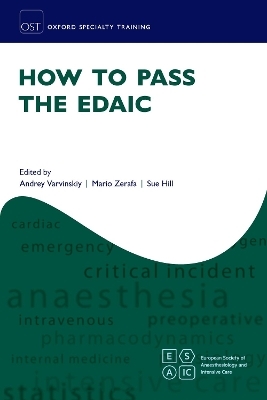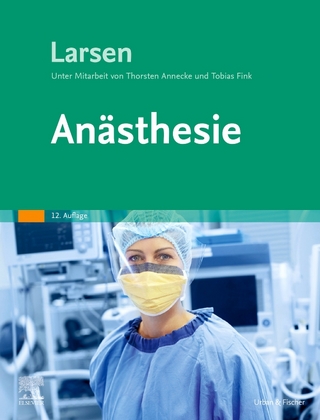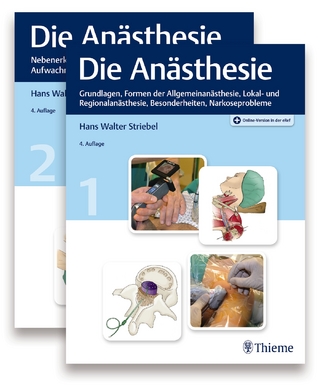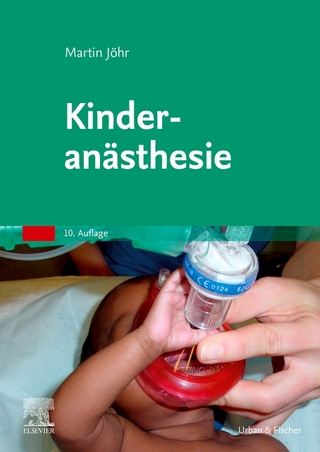
How to Pass the EDAIC
Oxford University Press (Verlag)
978-0-19-886702-9 (ISBN)
For Part I: Paper A, there are 135 example questions and model answers on physiology, pharmacology, anatomy, physics, and statistics. For Part I: Paper B, another 127 example questions and model answers cover general anaesthesia, regional anaesthesia, special anaesthesia, intensive care, internal medicine, and emergency medicine.
To help candidates prepare for the Part II: the Oral part of the exam, there are five SOE-type questions and detailed worked answers addressing applied physiology, applied pharmacology, applied anatomy, clinical measurement, general anaesthesia, critical incidents, intensive care, and image interpretation for a total of 41 practice questions.
Written by top quality authors who are or were previously experienced examiners within the European Society of Anesthesiology and Intensive Care (ESAIC), this is an authoritative guide to the EDAIC exam.
Andrey Varvinskiy is a Consultant Anaesthetist at Torbay Hospital in Devon, UK. He is an examiner for both the Royal College of Anaesthetists since 2010 and the European Society of Anaesthesiology and Intensive Care (ESAIC) since 2006 and has been an ESAIC examinations Committee member since 2005 and Chairman 2018-2020. He specialises in airway management, regional anaesthesia, ophthalmic anaesthesia, and education. He graduated from the Arkhangelsk State Medical Institute (USSR) in 1986 and trained in surgery and anaesthesia at University Hospital of Arkhangelsk. After graduation, he continued to work at the same hospital as an Attending Specialist and Lecturer in Anaesthesia and Intensive Care till 1995, before moving to the UK. After completion of a full UK postgraduate training programme in Anaesthesiology and Intensive Care, in 2001 he was appointed Consultant Anaesthetist at Torbay Hospital. He is a UK Resuscitation Council certified BLS/AED, ALS Instructor and Course Director. Being multilingual, he has acted as a medical translator for several anaesthetic textbooks from English into Russian including "Miller's Anesthesia". He is a keen triathlete, cyclist, and swimmer.
Mario Zerafa graduated MD from the Medical School of the University of Malta, in 1987. He completed most of his Anaesthesia and Intensive Care training in the UK, specializing in Paediatric Anaesthesia at the Great Ormond Street Hospital, London. In 1998, he was appointed Consultant Anaesthetist with special interest in Adult Cardiothoracic and Paediatric Anaesthesia at Mater Dei Hospital, Malta and Senior Visiting Lecturer in Anaesthesia within the Faculty of Medicine and Surgery, University of Malta. In 2004 he was appointed the Founding President of the Malta Resuscitation Council. He is an ERC certified instructor in BLS/AED, ILS, EPILS, EPALS, ALS, European Trauma Course and Generic Instructor Course. Over the past two decades Dr Zerafa has held multiple European posts in Anaesthesiology: Past EDAIC Part II Subcommittee Chairperson 2016-2020; EDAIC Examinations Committee Member 2009-2021; EDAIC Part 2 examiner since 2011; ESAIC Council member for Malta 2015-2019, and more
Sue Hill graduated from Cambridge University in Natural Sciences in 1977 then completed a PhD in the Department of Pharmacology (1981). The majority of her anaesthesia training was at Southampton General Hospital where she was appointed a consultant from 1995 until retirement in 2017, specialising in Neuroanaesthesia. She was appointed as an Examiner for Part I to the Royal College of Anaesthesia (1999 - 2009) and became a member of and then chairman of the Primary FRCA MCQ subcommittee. She remained a member of the RCoA Examination Committee until my retirement in 2017, and was awarded the Humphrey Davy medal for Audit. She was appointed to the EDAIC Examination group in 2008, becoming Chairman of the Part I subcommittee (2010-2016). Dr Hill also established the On-Line Assessment (OLA) and also chaired that subcommittee (2012-2016) prior to her appointment as Chairman of the EDAIC (2016 - 2018). She also has a BSc in Mathematics from the OU (2006), specialising in Statistics and Computing.
1. Introduction and advice
1: Andrey Varvinskiy: Introduction
2: Andrey Varvinskiy: Structure of the EDAIC (Parts I and II)
3: Sue Hill: How to answer Multiple Choice Questions (MCQs)
4: Mario Zerafa and Sue Hill: How to Pass the Part II Examination
2. Practice Part I: Paper A
5: Armen Varosyan: Physiology
6: Sue Hill: Pharmacology
7: Mikhail Dziadzko: Anatomy
8: Andrey Varvinskiy: Physics, equipment and clinical measurement
9: Sue Hill: Statistics
3. Practice Part I: Paper B
10: Andrey Varvinskiy and Sue Hill: General anaesthesia
11: Svetlana Galitzine: Regional anaesthesia
12: Vladislav Firago and Altan Sahin: Special anaesthesia
13: Krisztina Madach: Intensive care
14: Nicolas Brogly and Estibaliz Alsina: Internal medicine
15: Duncan Lee Hamilton: Emergency medicine
4. EDAIC Part II: Oral Guided Questions
16: Else-Marie Ringvold and Andrey Varvinskiy: Applied physiology
17: Petramay Attard Cortis and Andrey Varvinskiy: Applied pharmacology
18: Duncan Hamilton and Mario Zerafa: Applied anatomy
19: Andrey Varvinskiy: Clinical measurements
20: Else-Marie Ringvold and Mario Zerafa: General anaesthesia
21: Petramay Attard Cortis and Mario Zerafa: Critical incidents
22: Stephen Sciberras and Mario Zerafa: Intensive care
23: Stephen Sciberras and Mario Zerafa: Image interpretation
| Erscheinungsdatum | 27.02.2023 |
|---|---|
| Reihe/Serie | Oxford Specialty Training: Revision Texts |
| Verlagsort | Oxford |
| Sprache | englisch |
| Maße | 156 x 234 mm |
| Gewicht | 606 g |
| Einbandart | kartoniert |
| Themenwelt | Medizin / Pharmazie ► Medizinische Fachgebiete ► Anästhesie |
| Medizin / Pharmazie ► Medizinische Fachgebiete ► Schmerztherapie | |
| Schlagworte | Europäisches Diplom für Anästhesiologie und Intensivmedizin • Europäisches Diplom für Anästhesiologie |
| ISBN-10 | 0-19-886702-6 / 0198867026 |
| ISBN-13 | 978-0-19-886702-9 / 9780198867029 |
| Zustand | Neuware |
| Informationen gemäß Produktsicherheitsverordnung (GPSR) | |
| Haben Sie eine Frage zum Produkt? |
aus dem Bereich


